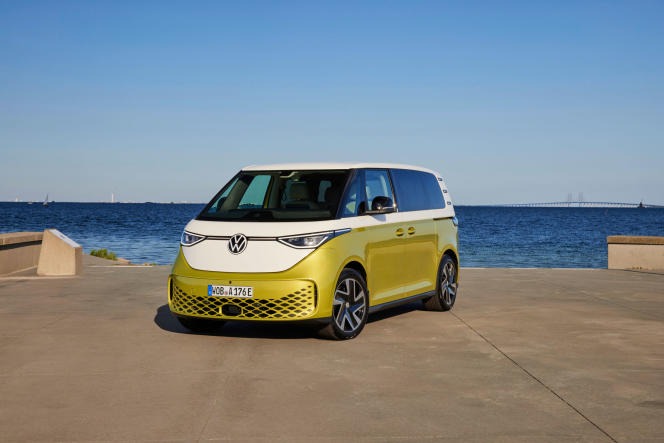The automobile market is depressed and the car has lost much of its aura, but there are still models capable of exciting the imagination and arousing enthusiasm. Reincarnation in electric version of the famous Combi of the Woodstock generation, the highly anticipated Volkswagen ID. Buzz has already sold two thirds of the 15,000 copies planned for this year, while the first deliveries are expected in November and it has not yet been exhibited in the commercial network. For its big comeback, this vehicle dear to surfers is benefiting from several waves: the strong growth in sales of electric vehicles, the fervor around vintage cars and the resurgence of the fashion for vacations in vans.
From the Combi, the ID. Buzz appropriated the imposing quickdraw, the flat surfaces, the V-shaped front end stamped with the enormous VW logo, the two-tone scheme with acid shades, the sliding doors and the installation of the engine between the rear wheels. It’s not nothing, but that’s about all. The German brand has limited winks to the ancestor and has not let itself be softened by neo-retro sentimentality. No curves or round headlights, but taut lines and slender headlights. Modern, functional and overpriced (its price starts, ecological bonus deducted, at 54,990 euros), the ID. Buzz, produced in Hanover, is aiming for 130,000 units per year, mainly intended for the European market, and conforms to the values of its time.
Technological endowment
The large 77 kWh battery installed between the axles offers a maximum range of just over 400 kilometers and is powered by a 170 kW DC and (only) 11 kW AC charger. It’s a bit tight to leave on the road to Kathmandu, but not to take a possibly large family to the island of Ré, a seven-seater version being planned for the end of 2023. The technological endowment of the heir is abundant. He can change lanes on his own on the highway and memorize his way to his usual parking space in order to complete the last fifty meters in autonomous driving. On some terminals, all you have to do is plug in the car, which will be automatically recognized and will launch a charging sequence without any other form of process, as at Tesla. The ID. Buzz bans animal leather and favors recycled materials.
Despite the capital of sympathy it has, it is difficult to feel a sense of complicity with regard to the ID. Buzz
4.71 meters long, this imposing car is powered by a 204 hp (150 kW) engine, which is not necessarily luxury, as it weighs 2.4 tonnes, almost double the first generation Combi which , certainly, did not have four good quintals (491 kg, precisely) of batteries to transport. The consumption on the road suffers and it will be necessary to gently approach the speed bumps like the tight turns. Driving is relaxing, silent, and the absence of a front engine helps to reduce the turning circle, just over 11 meters, and therefore to facilitate maneuvers. The glazed surface is more than generous and the sliding rear seat. It is possible to install a berth in the back and the utility version is appropriately called “Cargo”.
You have 26.25% of this article left to read. The following is for subscribers only.
We would love to give thanks to the writer of this write-up for this awesome web content
The Volkswagen Combi is no longer what it used to be
We have our social media profiles here as well as other pages related to them here.https://nimblespirit.com/related-pages/

